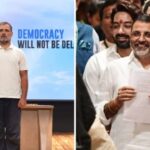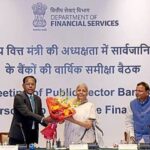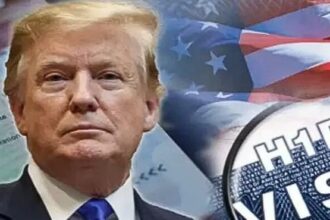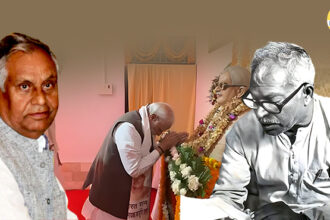“Every player wants to win gold, but I am glad that I won silver.” Iconic Indian weightlifter Mirabai Chanu told this author after winning silver at the Tokyo Olympic Games 2020 (2021). The road to Tokyo was marked by challenges for Chanu. Then, in Tokyo, she was carrying a huge weight on her chest. This weight was of “pressure”. She wanted to cry it out. But she would do that after the lift and on her mother’s shoulders, she said back then. Chanu suffered a performance setback at the Rio Olympic Games, where she failed to get past three attempts at 48 kg. She could not have let that weigh her down. Not in Tokyo. Here, she had to do something that would take India to the podium. To take India to the podium, she would have to crack the 49 kg, with nerves, without keeping the weight of pressure on the chest. She would do it with the coaching and support staff backing her. And she did it.
China’s Hou Zhihui was ahead of her. This was a medal for India after Karnam Malleswari’s own – in the 2000 Sydney Olympic games. Chanu told this author, “Jo maine kiya hai, training mein karke aayaa hai, usey ko main idhar karke… medal to jo main best performance degi to apne aap aa jaegi. Maine lift mein hee paas karne ke liye focus kiya thha. Paanch saal ka mehnat thha. (All that I have put into my training, I would use that, the medal would happen on its own if I gave my best performance. So, I kept the focus. It was, after all, about five years of hard work).”
Sustaining the glory, rescripting the story
Chanu recently made a comeback with her promising performance at the Commonwealth Championships. But now, there is a development in her weight category at the Olympic Games in Los Angeles in 2028. It has been dropped. Reports state that the International Olympic Committee (IOC) has officially dropped the 49 kg weight class. Reports say that she can continue to contest in her weight category till the 2026 Asian Games and will have to beef up for the LA 2028 contest.
With the recent development in her weight category, Chanu will have to focus on the different needs in the international arena, which will not be a problem for her, considering the support and facilities she receives to be a winner. Audience for sport is built through wins, wins are built through rigour, sweat, training, technical support, and investment. Karnam Malleswari reaching the podium was a breakthrough in Indian women sport, yet in the following years, there were women in sport who discontinued performing and training owing to financial constraints, lack of support, equipment and sport infrastructure. With marked improvement in facilities and technical support to athletes coming from the government at the centre, sporting dreams are being rescripted on the turf, mat, pitch and ground with one destination – the podium. Under PM Modi, this story has been completely rewritten. Encouraged by the incoming medals are aspiring athletes in rural and urban centres of sport, resulting in an upsurge in India’s sport story, not only at the Olympic Games, but across the competitive spectrum at the internal level and national arena.
From neglect to ‘effect’
The Congress government invested heavily in hosting the Commonwealth Games in New Delhi in 2010. Scams came attached. It is the event and the year that sections of the Left-aligned media view as the shaping of a cult, particularly for women in sport. In reality, the years between 2010 to 2013-2014 actually signify the era of cuts. The sports budget spiralled down — from ₹3,229 crore in 2010–11 to just ₹874 crore by 2013–14. Today, the budget is ₹3,800 crore. And padding this budget are scholarships, stipends, and direct financial aid that have percolated into India’s new sport culture to become a new norm. Heartening is the fact that over 800 former champions serve as coaches across disciplines, giving back their all to that one passion they dedicated their teen years and youth.
PM Modi’s era has been marked by champions being uplifted even in the departments they serve as professionals. Anju Bobby George was not so lucky during her era. Today, the scale of expectations and delivery has transformed to an extent that even a state like Bihar, where sport suffered for decades under misgovernance, is uplifting sport and sport champions by honouring excellence with government jobs. The scenario is different now, under the Modi government, where the focus is not on performance alone, but on preserving dignity, belief and confidence.
National pride through action, achievement, accolades
The outcome of an initiative that is given the name Target Olympic Podium Scheme (TOPS) was meant to live up to the purpose. The popular and engaging videos of shooter Manu Bhaker over training and diet sessions from a foreign destination before the Paris Olympic Games 2024, symbolised a journey that would shape a podium breakthrough. India’s sporting structure and governance was waiting for initiatives such as TOPS, where athletes receive generous dimensions of inputs that reduce the distance to the podium with world-class training, exposure on foreign turfs, the best equipment, and monthly stipend across two different categories of athletes – core (₹50,000 ) and developing ₹25,000). Today, India’s top 152 athletes are being given the required training from the best coaches in the world along with the edge-provider — sports science support.
Sections of Left-aligned media recall the 2010 CWG Games held in Delhi as the turning point for women in international sport. They seem to ignore ASMITA, an ambitious initiative of the Modi government designed to give sport excellence gendered outcomes in one of the largest movements in sports undertaken by India, in which, according to government data, now, 1.9 lakh athletes compete across 1,660 plus leagues in 29 sports across India – penetrating rural and urban pockets. India’s upcoming progress in rugby has witnessed positive outcomes of ASMITA. And this is no passing fancy.
The value of government interventions in India’s sport endeavour at the international arena can be gauged by how India’s leap to the podium has shifted between India’s dismal show in London Olympic 2012 to the spurt of promise displayed in Rio Olympic 2016, to the unfolding of success in Tokyo Olympic 2020 (2021) and Paris Olympic 2024. While several sections of media look for conspiracies in India’s cultural ascendancy or socio-cultural progress and upsurge, they showed little or no interest in how India under PM Modi was witnessing a multi-pronged churning in sport at international contests while discarding the habit of being satisfied merely by being part of the contest. During those years, “satisfaction” meant India’s presence – with the contingent waving at international spectators — at glittering opening ceremonies or the games village. Satisfaction over mere presence has been replaced by a strong appetite for medals — where each medal counts.
Discarding old habits for breakthroughs, consistency and confidence
Apathy towards sport, sportsmen and sport infrastructure, too, becomes a habit. At the grassroots level, the paucity of funds and lack of basics – even running shoes, equipment, hockey sticks even, was often romanticised. The smallest governmental efforts count. The smallest lack of input pinches. Past is a great teacher when it comes to lessons. PT Usha missed the Olympic podium by a whisker. It was by 1/100th of a second. We have hailed her as a hero. But we wonder if a time shuffle meant she could sprint today – under TOPS. Much water has flown in hockey after two Olympic bronze medals, but one wonders if politicians in 2008 asked Rajpal Singh what he was going through in Chile after missing the contest berth for 2008 Beijing Olympic Games.
Those images of dejection do not leave the mind. I have heard directly from Rajpal Singh and others in the squad about the pain of not featuring in the contest – and without wanting much to look back, today, I can say that the recovery took them long, really long. Then, it took India decades to crack athletics at the Olympic Games till Tokyo. Failure has no takers, it is said. But when success in international sport comes attached to good sport governance of the Modi government, sections of the media look away from it or bypass aspects that make it possible for Indian teams and squads to shake off low expectations and low targets.
Within the span of a venue shift – from Tokyo to Paris, in men’s hockey, India maintained its position on the podium – defending the bronze, showing confidence and consistency, which should surge in the coming years. For followers of hockey such as this author, four decades of drought ended in Tokyo, was as much an occasion for a burst of joy surpassing all previous emotions over hockey success and failures, as a moment for discontent – over decades lost owing to government apathy, mismanagement, politics, and disconnect with players and their pains.
Hockey’s transformation in India is the boldest example of how differently and well sportspersons respond to government support, fair opportunity and the organised strength of facilities at all times of their performance graph.
The mindset for medals
Under PM Modi, that story is not restricted to hockey alone, but is trickling into other disciplines. During the three Olympic Games held between 2014 and 2024, India secured 15 medals. Breaking up the count is not necessary but interesting. So, let’s go for it. In Tokyo 2020 (2021), India won 7 medals – an improvement from 2 in Rio 2016, and 6 in Paris 2024. In Tokyo, the spread of medals was across athletics, hockey, badminton, wrestling, weightlifting, and boxing. In Paris, India’s shooters punched a new breakthrough. Each medal in Tokyo and Paris was a knock, announcing India’s arrival to a new era – against 26 medals that India won – which was owing to the sporting greatness and sweat of the athletes making a mark with the limited resources dispatched to them between 1900-2014.
However, one of the most brilliant aspects of governmental intervention and a whetted sport policy under the Modi government is the way India’s representation at the Paralympics has turned out. Before recalling the medal count, this author wants to state that it was emotion alone that won the game before even the clockwork to a new shift began. The emotion was PM Modi’s call for recognition, dignity, and support for Paralympic athletes in the sport arena alongside the simultaneous call for the rights, welfare and dignity of Bharat’s Divyang community in India’s social and political spheres. Modi government erected a system that worked to bring improvements in the practice and performance curve of Paralympic athletes.
In 2015, a year after coming to power at the Centre, PM Modi popularised the use of the term “Divyang” to instil a shift in social attitudes towards Bharat’s disabled. Instead of “disabled”, the term encouraged in India’s social parlance – “Divyang”- meant people who are divinely-abled. It was natural that the celebration of dignity and abilities in the Divyang community in PM Modi’s vision would correspond to sport and sport support for the Paralympic Games. The outcome was “divya” and “bhavya”. India won 19 medals in Tokyo 2020 (2021) Paralympic Games against 4 medals in Rio 2016. The count spiralled to 29 medals in Paris. That’s a total of 52 medals against only 8 medals India won at Paralympics from 1968 to 2012. As a rising Asian leader in sport, India installed the best ever tally in 2023 – with 107 medals against 70 in 2018 at the Asian Games. In 2010, India secured 14 medals at the Para Asian Games. The count swelled to 72 in 2018 and 111 in 2023.
The track to excellence through sport governance
Consistency at medal-winning would come only when India’s able to explore, test, train, build and reinvigorate sporting talent beneath the top layer. And that’s happening. Khelo India ensured that the movement was nationwide, percolated to the grassroots, and was expanded to the national level. Each year under Khelo India, Bharat turns into a vast landscape of competitions involving young talent that, in the coming years, would fight for spots in national squads and teams, continuously-honing their capabilities towards excellence. Government data says that over 50,000 athletes have featured as competitors under Khelo India, while 3 lakh at the district level have tested their mettle on the different playgrounds. Beyond the call for national talent, Khelo India is understood as one of the most underrated initiatives that inculcates a sporting culture and a positive lifestyle in India’s young achievers. The spotting of talents has contributed its own harvest. Government data highlights an engaging representation — 52 athletes at Paris 2024 won 10 medals. Today, nationwide interaction with competitions of repute features in Youth Games, University Games, Para, and Winter Games. The penetration of opportunity-building in different regions in Beach, Tribal, and Water Sports is bound to produce new stories of sporting brilliance.
Sports governance is not about doing things differently or randomly. It is about taking up a professional approach in weighing benchmarks, talent, and instilling accountability in the system dealing with sport and sportspersons. The Modi government has brought reforms in policy and sport administration with the National Sports Governance Act 2025, ceasing the habit of ad-hocism that was given the name of “format” and “culture”. The National Sports Board, a Sports Tribunal for swift dispute resolution, and an Election Panel to ensure clean governance in federations help the keepers of sport excellence during crucial hours in performance, practice or difficult moments of their career graph. The introduction of Khelo Bharat Niti 2025 is intended to make sport integral to education and other dimensions of living and performance.
This author has seen the dismal era of Sports Authority of India infrastructure in Uttarakhand and other towns and cities during the 1980s, 1990s and the 2000s. The scope of improvement exists even today, but SAI has witnessed a contrasting era with 23 National Centres of Excellence. The current government seems working on a mission mode with sport infrastructure upgradation – taking the number of projects from 38 in 2014 to 350. The glimpses of change are visible at New Delhi’s Jawaharlal Nehru Stadium which has been upgraded with Mondo tracks. The stadium hosted the World Para Athletics Championships. In Gujarat, the state preparing to host the 2036 Olympic Games, the Narendra Modi Stadium will embrace a global story with unflinching government effort, ideas and inputs of scale that would reflect India’s calibre as a host and participant. Then there are surprises. Bihar – as the rising story in Indian competitive sport is one. Good governance will deliver more. It is PM Modi’s game and he is whetting sport policy well for 2036 — like a pro.









